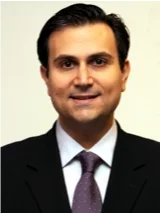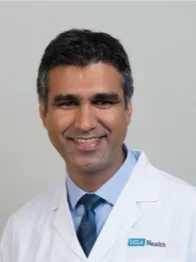Cardiac Repair, Regeneration, and Heart Failure
Scarring: A Cause of Heart Failure
The heart does not possess a robust ability to regenerate and heals by scar formation. Multiple studies have demonstrated that the amount of scar tissue in the heart is an independent predictor of morbidity and mortality. Scar tissue reduces cardiac function and induces the formation of more scar tissue, which leads to cardiac arrhythmias and sudden death.
The laboratory of Arjun Deb is devoted to the study of the biology of scar and how scarring can be modulated therapeutically. The spatio-temporal mechanisms regulating scarring are conserved across many organs and “thus the hope is if one can alter scarring in one organ, the therapeutic principles can be applied to other organs” as well, says Dr. Arjun Deb, the director of the UCLA Cardiovascular Theme.
Changing the Fate and Size of Scar Tissue
Reversing scarring, or preventing it in the first place, has been one of the major challenges of cardiovascular research, says Dr. Arjun Deb, a professor of medicine (cardiology) and senior author of a UCLA study published in 2014 in Nature. Their group was the first to show that cells in scar tissue retained cellular plasticity for a brief time window and could be manipulated to change the amount of scarring.
More recently, the Deb Lab has demonstrated that scars have an inherent ability to control their own size (Yokota et al. Cell 2020). The lab showed that type V collagen, a minor constituent of scar tissue regulated the mechanical properties of the scar tissue and mechanosensitive receptors on fibroblasts sensed changes in mechanical properties of scar tissue to determine the volume of scar to be formed. The lab used small molecules to interfered with such feedback mechanisms and showed scar size could be altered in this manner to therapeutic advantage.

Chromatin Organization and Heart Failure
The Vondriska Laboratory studies the biology of chromatin and how chromatin reorganization occurs in heart failure. In recent years, the lab has carried out the first chromatin conformation capture experiments in the heart, determining the endogenous organization of the genome in cardiac myocytes. With this blueprint, the lab is answering the following questions: How do transcription neighborhoods form? What is the role of inter-chromosomal interactions and other nuclear features in genomic architecture? How do features of local accessibility relate to local and global architecture?
The lab is determining the structural features required for disease-associated gene expression and investigating how global chromatin accessibility is altered during cardiovascular disease. These studies are targeted to identify diagnostic features of the epigenome that indicate the progression or reversion of disease and to develop strategies to remodel chromatin therapeutically.
Cardiac Oncology and Imaging

The Packard Lab studies the biology of atherosclerosis and heart failure with particular emphasis in understanding how chemotherapeutic drugs exert toxic effects on the heart.
The lab integrates molecular and cellular techniques to dissect mechanisms of chemotherapy-induced cardiotoxicity as well as designs novel imaging techniques to visualize myocyte contraction in real time. The Packard Lab has created a new imaging technology (DIAMOND) that can determine segmental abnormalities in cardiac contraction following administration of chemotherapeutic agents.

Pulmonary Hypertension and Right Heart Disorders
The Umar Laboratory's research is focused on investigating the molecular mechanisms and pathophysiology of primary and secondary forms of pulmonary hypertension and associated right ventricular dysfunction. The lab’s long-term goal is to devise novel regenerative therapies for these cardiopulmonary disorders. They are also interested in investigating novel strategies for perioperative cardiopulmonary organ protection.
Pulmonary hypertension is a chronic pulmonary vascular disease without a definitive cure. The Umar Lab is using state-of-the-art in vivo mouse and rat models, in vitro cell culture systems, and human blood and tissue samples to investigate the molecular mechanisms of the development of primary and secondary pulmonary hypertension. The lab is also investigating adverse structural and electrical remodeling of the right ventricle secondary to pressure overload that often leads to arrhythmias and sudden cardiac death.